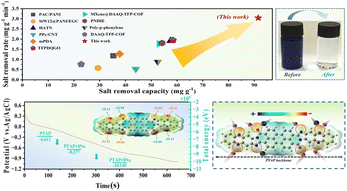Capacitive deionization (CDI) is emerging as a promising technology for efficient water treatment, where the electrochemical performance is strongly influenced by the activity of electrode materials. Among these, faradaic organic electrodes with pseudocapacitive behavior offer great potential but remain limited due to insufficient redox-active sites and poor electron affinity, factors that constrain their ion adsorption capacity and desalination rate. In this study, we present a novel electron-delocalized organic molecular architecture, PTAP, which features a rigid conjugated backbone and dual redox-active centers located at C![[double bond, length as m-dash]](https://www.rsc.org/images/entities/char_e001.gif) N and C
N and C![[double bond, length as m-dash]](https://www.rsc.org/images/entities/char_e001.gif) O coordination sites. The molecular structure, optimized via extensive π-electron delocalization and a narrow HOMO–LUMO energy gap, significantly enhances Na+ adsorption kinetics and facilitates efficient charge carrier transport. A combination of comprehensive experimental techniques and density functional theory (DFT) calculations was employed to elucidate the Na+ electro-adsorption pathways and identify the active redox moieties. The resulting PTAP-integrated CDI device exhibited outstanding desalination performance, achieving an exceptionally high salt removal capacity of 91.50 mg g−1—far exceeding that of conventional organic-electrode CDI systems (typically < 60 mg g−1)—and a rapid removal rate of 3.05 mg g−1 min−1 at 1.2 V, while maintaining excellent cycling stability (∼95.55% retention over 100 cycles). Furthermore, a multi-module CDI system incorporating PTAP electrodes was developed, demonstrating high desalination efficiency in hypersaline environments. This system also enabled preliminary exploration of sustainable real-world applications, including dye-contaminated wastewater remediation and energy harvesting, underscoring the versatility and transformative potential of PTAP-based CDI technology.
O coordination sites. The molecular structure, optimized via extensive π-electron delocalization and a narrow HOMO–LUMO energy gap, significantly enhances Na+ adsorption kinetics and facilitates efficient charge carrier transport. A combination of comprehensive experimental techniques and density functional theory (DFT) calculations was employed to elucidate the Na+ electro-adsorption pathways and identify the active redox moieties. The resulting PTAP-integrated CDI device exhibited outstanding desalination performance, achieving an exceptionally high salt removal capacity of 91.50 mg g−1—far exceeding that of conventional organic-electrode CDI systems (typically < 60 mg g−1)—and a rapid removal rate of 3.05 mg g−1 min−1 at 1.2 V, while maintaining excellent cycling stability (∼95.55% retention over 100 cycles). Furthermore, a multi-module CDI system incorporating PTAP electrodes was developed, demonstrating high desalination efficiency in hypersaline environments. This system also enabled preliminary exploration of sustainable real-world applications, including dye-contaminated wastewater remediation and energy harvesting, underscoring the versatility and transformative potential of PTAP-based CDI technology.


